Describe Solstices and the Equinox Easy Facts for Kids
Astronomy has been important to people for thousands of years. The ancient construction known as Stonehenge in England may have been designed, among other purposes, to pay special honor to the solstices and equinoxes. These are the times and locations during Earth's journey around the sun that we humans have long used to mark our seasons.
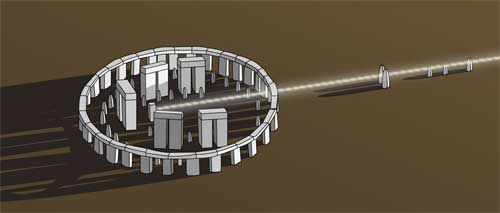
Here is a guess at how Stonehenge might have looked about 2400 BC. At dawn on the Summer Solstice, the rays of the sun would have shone straight through what is called the "slaughter stones" to exactly strike the "altar stone" in the center.
But what is the solstice exactly?
It has to do with some imaginary lines on our planet. These lines are important, because they help people navigate and measure time.
The equator is an imaginary line drawn right around Earth's middle, like a belt. It divides Earth into the Northern Hemisphere and the Southern Hemisphere.
Another imaginary line drawn straight through Earth connecting the North Pole to the South Pole is Earth's axis of rotation. This line is tilted 23.5° from Earth's orbital path around the sun. This tilt is the cause of Earth's seasons.
Earth's axis of rotation is tilted 23.5°. That makes the latitudes of +23.5° and −23.5° special. But how? Other useful, but imaginary, lines around Earth that are parallel to the Equator are called lines of latitude. They are numbered from 0° to 90°. The one at 0° is the equator itself. The higher the number, the farther north (if it's a + number) or south (if it's a − number).
You may have noticed two special lines of latitude on a globe of the world: One in the Northern Hemisphere called the Tropic of Cancer at +23.5° latitude and one in the Southern Hemisphere called the Tropic of Capricorn at − 23.5° latitude.
At these latitudes, the sun is directly overhead around noon on the solstices. In the Northern hemisphere, the Summer Solstice occurs when the sun is directly above the Tropic of Cancer, usually June 21. In the Southern Hemisphere, the Winter Solstice occurs when the sun is directly above the Tropic of Capricorn, usually December 21. The solstice days are the days with the most (for Summer) or fewest (for Winter) hours of sunlight during the whole year.
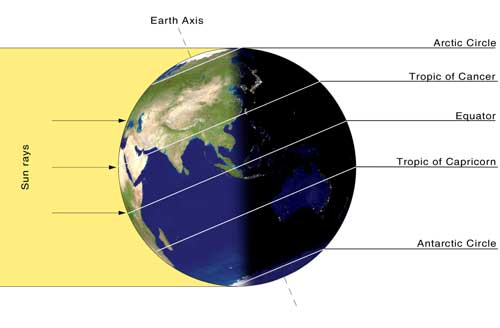
The sun is directly overhead at "high-noon" on Summer Solstice at the latitude called the Tropic of Cancer. Credit: Przemyslaw Idzkiewicz, via Wikipedia Commons.
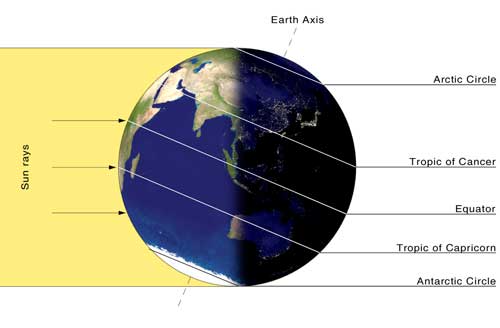
The sun is directly overhead at "high-noon" on Winter Solstice at the latitude called the Tropic of Capricorn. Credit: Przemyslaw Idzkiewicz, via Wikipedia Commons.
The sun is directly overhead at "high-noon" on the equator twice per year, at the two equinoxes. Spring (or Vernal) Equinox is usually March 20, and Fall (or Autumnal) equinox is usually September 22. Except at the equator, the equinoxes are the only dates with equal daylight and dark. At the equator, all days of the year have the same number of hours of light and dark.
Between the two tropics zones, which includes the equator, the sun is directly overhead twice per year. Outside the tropic zones, whether to the south or north, the sun is never directly overhead.
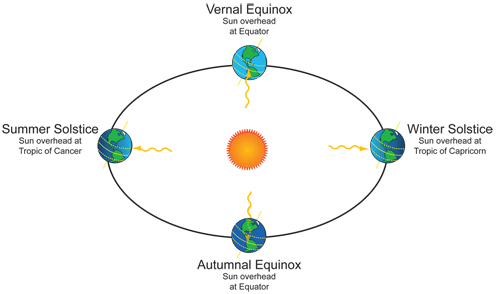
Two other significant lines of latitude are the Arctic Circle (around the North Pole) and the Antarctic Circle (around the South Pole). These circles are as far from the poles as the Tropic of Cancer and the Tropic of Capricorn are from the equator. On the Arctic Circle, the sun does not set at all on the Summer Solstice. On that one day, the sun traces a complete circle just above the horizon as the Earth rotates. On the Antarctic Circle, the sun does not set at all on the Winter Solstice.
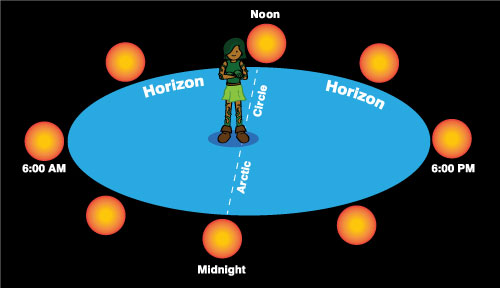
As you go closer to the poles, you have more and more days when the sun does not set (or rise), until, at the poles, the sun remains above or below the horizon for six months at a time.
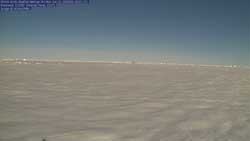
A webcam at the North Pole captured this picture on June 21, 2010.
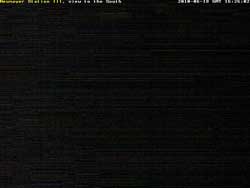
A webcam at the South Pole captured this picture on June 18, 2010, at high noon.
More than "imaginary" to GOES . . .
The equator is a very important "imaginary line" for the GOES and GOES-R series weather satellites. They orbit exactly above the equator, at a very great distance (22,300 miles), which allows them to make just one orbit per day.
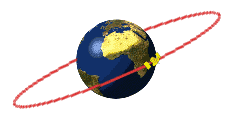
They "hover" over one point on Earth's equator. That way, they have a full view of almost one-half of Earth and can keep a continual watch on developing weather. Find out more about satellite orbits.
Tropic of Cancer? Tropic of Capricorn? Who came up with those names?
These names were thought up about 2,000 years ago. At that time, the Sun was in the direction of the constellation Cancer at the Summer Solstice in June. However, this is no longer true. Earth's axis wobbles a bit, slowly changing the direction in which it points.
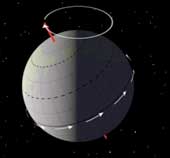
Over 26,000 years, the axis traces out a small cone shape. At this time, the Sun is in Taurus or Gemini (depending on where you draw the boundary between them) at the Summer Solstice. The word "tropic" itself comes from the Greek τροπή (tropi), meaning turn, referring to the fact that the sun appears to "turn back" at the solstices.

In this chart of the zodiac, the Sun is in the constellation Cancer.
When the Tropic of Capricorn was named, the Sun was entering the constellation Capricorn at the Winter Solstice in December. In modern times the Sun appears in the constellation Sagittarius during this time.
Source: https://scijinks.gov/solstice/
0 Response to "Describe Solstices and the Equinox Easy Facts for Kids"
Post a Comment